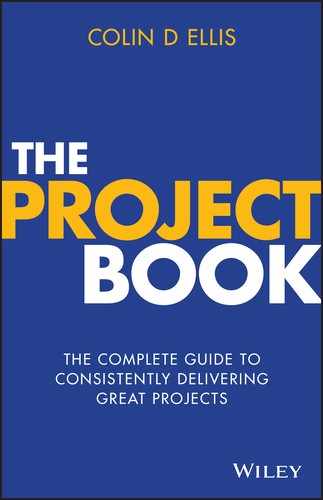CHAPTER 43
AGILE
Agile is the current buzzword in organisations worldwide. If you’re reading this in 2025 (hey, you never know), then you’re probably wondering what all the fuss was about.
Essentially, we’re currently rubbish at delivering projects because — some would say — we try to define too much at the start (using the waterfall method) and it doesn’t allow for the customers’ confusion, whims or dramatic U-turns.
As a concept, agile has been around for a while, but it came to prominence in 2001 with the signing of the Agile Manifesto after 17 software developers met at the Snowbird ski resort in Utah to discuss better and quicker ways to get products to market. Agile values include:
- individuals and interactions over processes and tools
- working software over comprehensive documentation
- customer collaboration over contract negotiation
- responding to change over following a plan.
These values are supported by 12 principles for developing ‘agile software’. There are numerous agile methods, and software developers can get into really heated discussions about which is best. The most popular ones are Scrum, Lean, Kanban, XP (Extreme Programming) and DSDM (Dynamic Systems Development Method).
Compared with the waterfall method (A+B+C+D=E), agile approaches are much more fluid, often comprising a series of shorter projects within a project, with the product being developed iteratively. This means a team of people works on the requirements, design, build, testing and implementation of one smaller component to create the first iteration of the product, usually called a ‘sprint’ — A=E version 1, A+B=E version 2, A+B+C=E version 3 and so on.
Agile projects still require strong leadership and the development of a different culture. Contrary to what you might think, there still needs to be a plan. As Alistair Cockburn (one of the signatories of the Agile Manifesto) said at a conference in Melbourne, ‘If people think that agile is a way to rid ourselves of project managers, they’re wrong. On the contrary, we need good ones more than ever’. What sets those who lead agile projects apart from those who deliver waterfall projects is their mindset.
While there is a structure to agile methods such as Scrum, there’s also a fluidity to product delivery that you don’t find in waterfall projects. Those leading and sponsoring agile projects need to be open to constant change and comfortable with ambiguity. People who are good at managing waterfall projects may not necessarily make good agile project managers, and vice versa. However, as with most things in our world, you can learn the skills, providing you have the right mindset and the determination to do so.
Pros and cons of agile project management
| Pros | Cons |
| Agile is much more flexible in its approach to scope (i.e. there’s no need to understand every detail up front). | It’s often used as a way of short-cutting projects more suited to a waterfall approach. |
| You get to see your product develop (usually every two to four weeks). | People think it’s a silver bullet and will tell you it’s the only way to succeed. It’s not. |
| The process is much more collaborative. | Stakeholders don’t realise the time commitment involved. |
